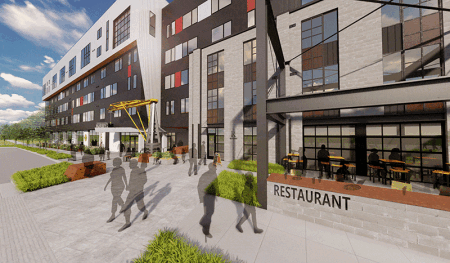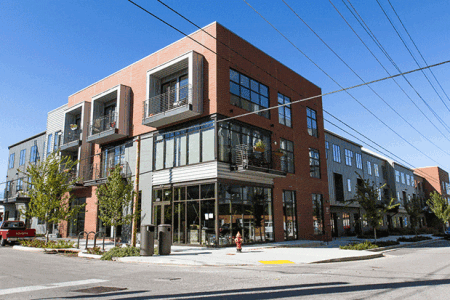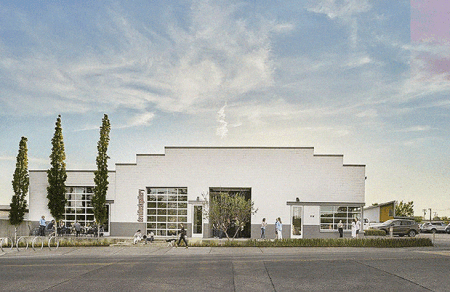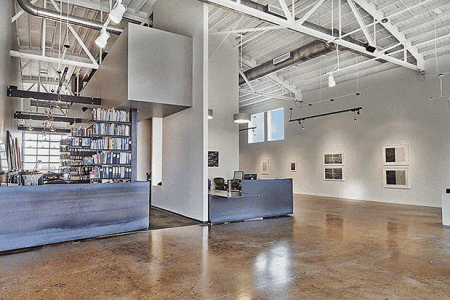In the heart of Nashville’s Wedgewood-Houston area, Kirby Welding Company’s giant crane arm, designed to lift massive mixing drums off concrete trucks for repair, was once emblematic of the grit and muscle of an old-school, light-to-medium industrial neighborhood, a place that manufactured everything from socks to sausages to the Beatles’ early records.
Today, many of those businesses have vanished from the neighborhood, but the crane arm remains. It is being moved out to the front of the building, which is being transformed by local outfit Core Development into Kirby, a five-story mixed-use project that will include 104 condo residences, 4,000 square feet (372 sq m) of dining uses, and 5,000 square feet (465 sq m) of ground-level commercial space. “We’re taking the industrial artifacts from the building and celebrating them as part of the architecture and the streetscape,” explains architect Nick Dryden of the Nashville-based firm DAAD.
But Wedgewood-Houston, also known locally as WeHo, is about more than industrial-age nostalgia. Kirby, for example, will include room for “maker space” that could attract some of the craftspeople and artists who have become the neighborhood’s driving force. “It’s ideal for creative people who want to live and work in the same building,” Core CEO and ULI Nashville chair Mark Deutschmann explains.
Wedgewood-Houston remains a place that makes things and fixes things, except these days the wares are different—custom high-value products, ranging from craft cider and bespoke men’s clothing to aerial drones.
“We have furniture manufacturers, and there’s a lumber company that does reclaimed woodwork,” says Colby Sledge, a Metro Council member who represents the neighborhood. “People are making everything from bread to beer and whiskey. It’s still manufacturing, but it’s occurring in a very 21st-century style.” In addition, there are studio and gallery spaces for artists, and a recording studio owned by the popular rock band Kings of Leon. There even is a cookbook author who uses one of Core Development’s live/work space’s kitchens to test recipes.
Wedgewood-Houston’s current vitality is something that would have been hard to imagine just a few decades ago, when the departure of traditional businesses sent the neighborhood into such a steep decline that at one point the city government considered demolishing some of it to build a municipal solid waste transfer station. But after community activists managed to block that plan, the neighborhood began to evolve and reinvent itself as a haven for artists and craftspeople. Developers also began to see its potential, given the proximity to downtown Nashville and the abundance of aging industrial buildings that could be renovated and repurposed.
Today, the area has morphed into what some locals call a “makerhood,” where former factories and industrial buildings are now home to a range of 21st-century creative businesses, from art galleries and studios to craft distilleries and maker spaces for small-scale, high-value manufacturing. In addition to being a laboratory for the reimagining and repurposing of land and structures, Wedgewood-Houston provides a template for how stakeholders—developers, local entrepreneurs, community organizations, and government officials—can work collaboratively to rebuild an area while still striving to preserve its distinctive identity.
A Lab for Urban Innovation
For much of its history, the area where Wedgewood-Houston is located—whose borders include Houston Street to the north, Wedgewood Avenue to the south, Eighth Avenue South to the west, and Fourth Avenue South/Nolensville Pike to the east—was a nameless neighborhood that morphed in the early 1900s from farmland to factories and humble brick cottages for workers. Its first great anchor was May Hosiery, a massive mill started by a German immigrant that for eight decades knitted footwear that store chains such as Montgomery Ward sold. The mill even produced socks worn by the Apollo astronauts.
Over the decades, the neighborhood also became home to businesses ranging from a dog food factory to Southern Plastics, later renamed United Record Pressing, which opened the South’s first vinyl record–pressing plant there and which had an apartment over the factory to accommodate African American musicians who visited the city during the era of segregation.
But by the 1980s, the area was growing increasingly dilapidated. A group of neighborhood activists formed South Nashville Action People (SNAP), a community organization, and set up headquarters in a building that formerly housed a rough-and-tumble tavern. SNAP raised $1.5 million in grant money to restore homes in the neighborhood and stave off condemnations, according Kat Jones, the organization’s executive director. As the old factories began to close, SNAP fought hard to keep the neighborhood alive, defeating a 1993 proposal to build a trash transfer plant there. To give the area more of an identity, residents came up with a stately sounding name, Wedgewood-Houston, after two streets running along its edges.
Eventually, the neighborhood’s vacant industrial spaces attracted artists and craftspeople, who by the early 2010s were flocking to Wedgewood-Houston. “It was a perfect place to incubate the sort of maker movement that we’re really starting to see take hold,” says Sledge, who moved there eight years ago.
Fort Houston, a subscription coworking maker space that opened in 2012 and has occupied two different locations in Wedgewood-Houston, also helped raise the neighborhood’s profile. “The word maker wasn’t even being used at the time, but we knew these people were out there,” says cofounder Ryan Schemmel. After initially targeting hobbyists and artists, Fort Houston expanded its vision to small companies that needed access to tools and manufacturing space. Since then, it has served as an incubator for 225 small companies. “We started to have a microeconomy, where they would hire each other for jobs,” Schemmel explains.
Other creative professionals followed the artisans’ lead. After Nashville architect Manuel Zeitlin did a master plan for the renovation and conversion of a former trucking garage on Wedgewood-Houston’s Hagan Street by developer Scott Chambers, Zeitlin and his wife, Janice, decided to move their businesses into the building as well in 2013. The space now doubles as the Zeitgeist art gallery and the studio for Manuel Zeitlin Architects (MZA).
Zeitlin sees Wedgewood-Houston as an incubator for makerhood-oriented design innovations. “Instead of development projects being isolated, you can tie them together with the alleyways.” He envisions transforming those passages into “maker ways” filled with small workshops, bars, galleries, and retail. “I have a friend who wants to do a combination bourbon bar and bookshop,” he notes.
Leveraging Neighborhood Collaboration
About four to five years ago, the area also caught the attention of Core’s Deutschmann, a developer with several decades of experience identifying promising urban neighborhoods and then launching strategic projects to help revive local commercial districts and add momentum to their ascent. (He also is the founder of Village Real Estate Services and author of the book One-Mile Radius: Building Community from the Core, published by Advantage in 2017.)
“The neighborhood [Wedgewood-Houston] had become an underutilized industrial zone,” Deutschmann says. “But some of the old buildings had character and were filled with makers and artists doing cool things. It had the components to become an urban magnet.”
He also noticed how it was situated between downtown—“it’s probably a mile [1.6 km] from Music City Center as the crow flies”—and the older ring residential neighborhoods.
“Like many cities, these ring neighborhoods fell victim to urban flight,” Deutschmann says. “These neighborhoods started shifting and changing as people moved back toward the city. These neighborhoods attracted creatives—in the WeHo case—and academics from the universities and others who wanted to be close to the city core.”
Core ended up purchasing 9.5 acres (4 ha) of property, most of it contiguous, which was occupied by dormant industrial facilities, ranging from an old towing yard and a welding shop to a former concrete pump plant that was being used to store trucks. Originally, he envisioned quickly erecting dozens of cottages.
But after meeting with a group that included SNAP neighborhood activists, architect Zeitlin, council member Sledge, Metro Planning Director Rick Bernhardt, and others from the planning department, a different vision emerged.
“To our surprise, the neighborhood asked for more density, which was pretty unusual,” Deutschmann recalls. They wanted the new property to be the heart of the neighborhood, and preferred a range of uses, including live/work spaces and more commercial development.
That led Core to seek zoning modifications for a more ambitious mixed-use development, dubbed the Finery, which eventually will include 490 residential units, 80,000 square feet (7,400 sq m) of maker space, and 30,000 square feet (2,800 sq m) of dining uses.
Core’s efforts to engage with the community inspired neighborhood activists to make such meetings into a regular thing, explains Eric Malo, a Wedgewood-Houston resident and architectural designer who is co-chair of SNAP. With his artist/curator wife, Alysha, he organized Converge, a partner organization that holds regular design workshops where developers meet with residents to discuss potential projects and get feedback to shape them. “The earlier in the process that we can engage with a developer, the better,” he says. “Some will have a fixed idea of what they want to do, but we’ll still work with them to finesse and adjust it, unless it’s something that just doesn’t fit with the neighborhood.”
Core’s initial project in the Finery was Six10 Merritt, a 27-unit condo building whose first floor features Sassafras, a grocery that features locally sourced produce. The developer followed with Twelve60 Martin, a five-story building whose 47 units include both apartments and live/work spaces. Another part of the parcel, a 10,000-square-foot (930 sq m) garage, was transformed into Diskin Cider, a maker of craft cider which has a flourishing bar and restaurant on the premises. Segment at Pillow, a 34-unit residential building, also is in the works.
In addition, Core and global real estate firm Hines are partnering to develop two office buildings and a parking garage on the remaining acreage in the Finery. One of the buildings will be a timber structure under the Hines T3 brand, designed to evoke a traditional 20th-century industrial warehouse, and will include both creative office and possibly maker space, according to Hines managing director Vikram Mehra. It is intended to appeal to “creative and knowledge economy tenants,” Mehra says. “They’re looking for nontraditional environments, walkable, with an artistic soul.”
Meanwhile, across the street, Corsair Distillery—whose cofounder, Darek Bell, discovered Wedgewood-Houston around the same time that Deutschmann did—acquired an old printing shop to convert into its new headquarters facility, which includes retail space and a cocktail bar. “I wanted my employees to be around other creative people and to feed off the vibe of the neighborhood,” says Bell, who is among those who jokingly call the area “Wedgewood-Brewston” due to the concentration of craft alcohol makers.
“The building was in pretty rough shape,” Bell recalls. “We had to put a lot of work into it. We built a deck and added wood and exterior lighting along the front to make it look more friendly.”
Remaking an Industrial Landmark
Meanwhile, the old May Hosiery mill, which served for years as a maker space after sock production stopped, is undergoing a transformation. In 2015, it was acquired by Chicago-based AJ Capital Partners, which is renovating the four-acre (1.6 ha) site’s six buildings for conversion into a mixed-use complex with 150,000 square feet (14,000 sq m) of creative office space, whose tenants reportedly will include streaming service Apple Music. A 50-room boutique hotel also is in the works.
“We’ve found that there is a larger and larger tenant audience for this unique adaptive use type of real estate,” says AJ principal Uday Sehgal. “It’s becoming less of a pure creative-type thing.”
Architect Dryden, who is working on the project, says although May Hosiery’s structures are older than the rest of the neighborhood’s mid- to late-20th-century industrial buildings, they exemplify the neighborhood’s still-to-be-tapped potential.
Wedgewood-Houston has “pretty big footprint parcels and buildings, which really yield themselves well not just for housing and retail but for creative office space and larger-format programming,” he says. “You’re going to see a lot of creative space there, along with live/work housing, and studio space and maker space.”
But challenges remain. “This wasn’t a neighborhood that was designed for walking,” Bell explains. “We’re struggling with making it more pedestrian-friendly. It’s a work in progress. We’re trying to get more sidewalks, more light, to put up a stop sign on the corner where our distillery is to slow traffic down. We want to get that walkable urbanity.”
Wedgewood-Houston’s various stakeholders are also grappling with how to keep the makers, artists, and longtime residents from being priced out of the neighborhood.
Providing affordable housing is part of the equation. Nashville-based developer FMBC Investments is building an 83-unit residential project, 83 Freight, which will use repurposed shipping crates to provide apartments, with floor plans starting as compact as 320 square feet (30 sq m). “We’re trying to engineer an affordable component with a smaller living space,” says the firm’s president, Shawn Bailes. “As Nashville has grown more expensive, we’re trying to target people who are getting priced out.”
On the northeast edge of Wedgewood-Houston in the neighborhood of Chestnut Hill, Brooklyn-based outfit Bento Box is building a flexible-stay cohousing community with 89 residential units, seven storefronts, and restaurant space, which is using modular construction to reduce costs. Bento Box chief operating officer Justin Koziol says that the company is drawn to the area by what he calls the “maker vibe.”
Television actor (from the CMT series Still the King) and carpenter Jon Sewell, who moved to Wedgewood-Houston in 2006, has renovated a former sausage-packing facility and opened the Packing Plant, an exhibition and studio space that helps ensure that there is still room for emerging artists in the neighborhood. “We’ve built out a small room that we’re doing pop-out events in,” says Sewell, who acted as his own general contractor and used salvaged materials when possible. “It’s mostly attracting recent alums from art schools here, an edgy younger crowd.”
Ultimately, collaboration remains key for the makerhood’s success. “We’re faced with the question of how do we grow and still keep everything that had made this district work, and ensure that it remains as inclusive as possible,” Sledge notes. “Right now, we’re trying to figure out how to do that. It probably requires some intentionality from local government, and also from developers. But I think we’ve been very fortunate to have development partners who understand what the neighborhood has been trying to do.”












![Western Plaza Improvements [1].jpg](https://cdn-ul.uli.org/dims4/default/15205ec/2147483647/strip/true/crop/1919x1078+0+0/resize/500x281!/quality/90/?url=https%3A%2F%2Fk2-prod-uli.s3.us-east-1.amazonaws.com%2Fbrightspot%2Fb4%2Ffa%2F5da7da1e442091ea01b5d8724354%2Fwestern-plaza-improvements-1.jpg)


